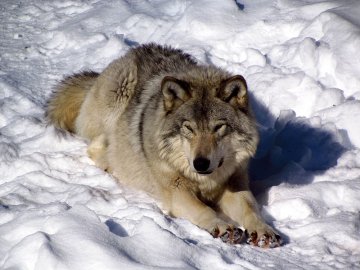Eastern Wolf

The eastern wolf, also known as the Algonquin Wolf or the Eastern Canadian Wolf, is a small to medium-sized wolf with a reddish or light brown coat. This species weighs between 45 and 80 pounds when full grown. They have some longer black hairs in the coat that increase in number as they get older. Despite being a distinct species, the eastern wolf is often mistaken for a subspecies of the red wolf or the grey wolf. They may also be mistaken for coyotes due to their build and coloring.
Reproduction
After mating, the pups are born two months later. The female retreats into a den and she will only come out once the pups are a few months old. She can have between four and seven pups per litter. The eastern wolf also mates with different types of coyotes. This has affected the overall genetics of this species.
Behavior
These wolves are most active at night but they may also be seen during the day. Additionally, they are quite dependent upon their pack’s social aspects and are very loyal to each other. Their packs mainly comprise of 3 to 6 adults on average. They do all they can to keep other packs out of their territory which is the reason why they are heard howling frequently in the wild.
Feeding
The eastern wolf is quite diverse in terms of diet. Although sometimes they may hunt on their own, most of the time they hunt with their packs. In most cases they hunt muskrat, beaver and rodents. However, they hunt moose and deer with their pack. Young wolves are fed regurgitated food. Unlike other type of wolves, the pack does not leave some adults to protect them. Pups are placed in dens to keep them safe until the pack returns. There is a good chance that the pups will be killed by other animals in case they venture out on their own.
Distribution
Eastern wolves are mostly found throughout Canada and around Mississippi and North Carolina in the United States. The eastern wolves mainly follow the White Tail Deer migration in order to ensure that they have plenty of food, especially in winter.
Conservation
The Coalition to Restore the Eastern Wolf, commonly known as CREW has been making conservation efforts to increase the number of eastern wolves that reside in the United States. Loss of habitat, hunting and trapping are some of the factors that have made the eastern wolf a potentially extinct species and hence a species of special concern. Breeding with coyotes threatens the genetic integrity of this particular species. These factors pose unique challenges to conservation efforts.
Human interaction
There have been a few cases where the eastern wolf has killed livestock in farming areas. As a result, ranchers and farmers have retaliated and started to hunt them, although this is illegal. Others have also been intentionally laying poison in areas where the eastern wolves will find it.
